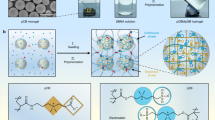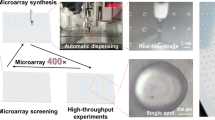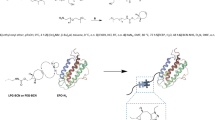Abstract
Although numerous studies have focused on poly(ethylene glycol) methyl ether methacrylate (PEGMA) hydrogels, the effect of the molecular weight and crosslinking of the monomer in its nonfouling properties remains poorly understood. Here, we prepared a series of PEGMA hydrogels from monomers of various chain lengths and identified structure/property correlations. The results revealed that the hydrogel hydration capacity depended on the chain length and crosslinking (from X-ray photoelectron spectroscopy analysis): for a similar initial amount of crosslinker, a lower monomer molecular weight resulted in a higher degree of crosslinking and a lower level of hydration. Protein (fibrinogen, lysozyme, human and bovine serum albumin) adsorption and bacterial attachment tests indicated that the structure of the PEGMA500 hydrogel was suitable (chain length, crosslinking) to minimize biofouling. A higher monomer molecular weight (as in PEGMA950) was associated with a higher hydrophilicity, but excessive free water in the cavities likely mediated foulant diffusion and trapping in the network. Conversely, a lower monomer molecular weight did not permit sufficient hydration to form a protective layer against fouling. These results were supported by blood cell (erythrocytes, leukocytes and thrombocytes) adhesion tests, suggesting that hemocompatibility can also be finely tuned by carefully selecting the monomer that constitutes the hydrogels.
Similar content being viewed by others
Log in or create a free account to read this content
Gain free access to this article, as well as selected content from this journal and more on nature.com
or
References
Chapman, R. G., Ostuni, E., Takayama, S., Holmlin, R. E., Yan, L. & Whitesides, G. M. Surveying for surfaces that resist the adsorption of proteins. J. Am. Chem. Soc. 122, 8303–8304 (2000).
Alcantar, N. A., Aydil, E. S. & Israelachvili, J. N. Polyethylene glycol–coated biocompatible surfaces. J. Biomed. Mater. Res. 51, 343–351 (2000).
Guidpati, S. C., Finlay, J. A., Callow, J. A., Callow, M. E. & Wooley, K. L. The antifouling and fouling-release performance of hyperbranched fluoropolymer (HBFP)-poly(ethyleneglycol) (PEG) composite coatings evaluated by adsorption of biomacromolecules and the green fouling alga Ulva. Langmuir 21, 3044–3053 (2005).
Zhao, W., Su, Y., Li, C., Shi, Q., Ning, X. & Jiang, Z. Fabrication of antifouling polyethersulfone ultrafiltration membranes using Pluronic F127 as both surface modifier and pore-forming agent. J. Membr. Sci. 318, 405–412 (2008).
Liu, B., Chen, C., Zhang, W., Crittenden, J. & Chen, Y. Low-cost antifouling PVC ultrafiltration membrane fabrication with Pluronic F 127: Effect of additives on properties and performance. Desalination 307, 26–33 (2012).
Yi, Z., Zhu, L. P., Xu, Y. Y., Gong, X. N. & Zhu, B. K. Surface zwitterionicalization of poly(vinylidene fluoride) porous membranes by post-reaction of the amphiphilic precursor. J. Membr. Sci. 385-386, 57–66 (2011).
Li, M. L., Li, J. H., Shao, X. S., Ming, J. J., Wang, B., Zhang, Q. Q. & Xu, X. P. Grafting zwitterionic brush on the surface of PVDF membrane using physisorbed free radical grafting technique. J. Membr. Sci. 405-406, 141–148 (2012).
Zhang, Z., Chao, T., Chen, S. & Jiang, S. Superlow fouling sulfobetaine and carboxybetaine polymers on glass slides. Langmuir 22, 10072–10077 (2006).
Carr, L., Cheng, G., Xue, H. & Jiang, S. Engineering the polymer backbone to strengthen nonfouling sulfobetaine hydrogels. Langmuir 26, 14793–14798 (2010).
Chen, S., Yu, F., Yu, Q., He, Y. & Jiang, S. Strong resistance of a thin crystalline layer of balanced charged groups to protein adsorption. Langmuir 22, 8186–8191 (2006).
Chen, S. & Jiang, S. A new avenue to nonfouling materials. Adv. Mater. 20, 335–338 (2008).
Mi, L., Bernards, M. T., Cheng, G., Yu, Q. & Jiang, S. pH responsive properties of non-fouling mixed-charge polymer brushes based on quaternary amine and carboxylic acid monomers. Biomaterials 31, 2919–2925 (2010).
Chang, Y., Chu, W. L., Chen, W. Y., Zheng, J., Liu, L., Ruaan, R. C. & Higuchi, A. A systematic SPR study of human plasma protein adsorption behavior on the controlled surface packing of self-assembled poly(ethylene oxide) triblock copolymer surfaces. J. Biomed. Mater. Res. Part A 93, 400–408 (2010).
Gunkel, G., Weinhart, M., Becherer, T., Haag, R. & Huck, W. T. S. Effect of polymer brush architecture on antibiofouling properties. Biomacromolecules 12, 4169–4172 (2001).
Chang, Y., Shih, Y. J., Ko, C. Y., Jhong, J. F., Liu, Y. L. & Wei, T. C. Hemocompatibility of poly(vinylidene fluoride) membrane grafted with network-like and brush-like antifouling layer controlled via plasma-induced surface PEGylation. Langmuir 27, 5445–5455 (2011).
Feng, X. & Pelton, R. Carboxymethyl cellulose: polyvinylamine complex hydrogel swelling. Macromolecules 40, 1624–1630 (2007).
Ding, X., Yang, C., Lim, T. P., Hsu, L. Y., Engler, A. C., Hedrick, J. L. & Yang, Y. Y. Antibacterial and antifouling catheter coatings using surface grafted PEG-b-cationic polycarbonate diblock copolymers. Biomaterials 33, 6593–6603 (2012).
Bass, M. & Freger, V. Facile evaluation of coating thickness on membranes using ATR-FTIR. J. Membr. Sci. 492, 348–354 (2015).
Shi, C., Yuan, W., Khan, M., Li, Q., Feng, Y., Yao, F. & Zhang, W. Hydrophilic PCU scaffolds prepared by grafting PEGMA and immobilizing gelatin to enhance cell adhesion and proliferation. Mater. Sci. Eng. C 50, 201–209 (2015).
Zhang, M., Li, X. H., Gong, Y. D., Zhao, N. M. & Zhang, X. F. Properties and biocompatibility of chitosan films modified by blending with PEG. Biomaterials 23, 2641–2648 (2010).
Zhang, C., Bai, Y., Sun, Y., Gu, J. & Xu, Y. Preparation of hydrophilic HDPE porous membranes via thermally induced phase separation by blending of amphiphilic PE-b-PEG copolymer. J. Membr. Sci. 365, 216–224 (2010).
Andreopoulos, F. M., Beckman, E. J. & Russell, A. J. Light-induced tailoring of PEG-hydrogel properties. Biomaterials 19, 1343–1352 (1998).
Iza, M., Stoianovici, G., Viora, L., Grossiord, J. L. & Couarraze, G. Hydrogels of poly(ethylene glycol): mechanical characterization and release of a model drug. J. Controlled Release 52, 41–51 (1998).
Cruise, G. M., Scharp, D. S. & Hubbell, J. A. Characterization of permeability and network structure of interfacially photopolymerized poly(ethylene glycol) diacrylate hydrogels. Biomaterials 19, 1287–1294 (1998).
Kim, I. S., Jeong, Y. I. & Kim, S. H. Self-assembled hydrogel nanoparticles composed of dextran and poly(ethylene glycol) macromer. Int. J. Pharm. 205, 109–116 (2000).
Lee, S. J., Kim, S. S. & Lee, Y. M. Interpenetrating polymer network hydrogels based on poly(ethylene glycol) macromer and chitosan. Carbohydr. Polym. 41, 197–205 (2000).
Bhattarai, N., Ramay, H. R., Gunn, J., Matsen, F. A. & Zhang, M. PEG-grafted chitosan as an injectable thermosensitive hydrogel for sustained protein release. J. Controlled Release 103, 609–624 (2005).
Ajji, Z., Othman, I. & Rosiak, J. M. Production of hydrogel wound dressings using gamma radiation. Nucl. Instrum. Methods Phys. Res. Sect. B 229, 375–380 (2005).
Fu, H., Rahaman, M. N., Brown, R. F. & Day, D. E. Evaluation of BSA protein release from hollow hydroxyapatite microspheres into PEG hydrogel. Mater. Sci. Eng. C 33, 2245–2250 (2013).
Ito, T., Yoshida, C. & Murakami, Y. Design of novel sheet-shaped chitosan hydrogel for wound healing: a hybrid biomaterial consisting of both PEG-grafted chitosan and crosslinkable polymeric micelles acting as drug containers. Mater. Sci. Eng. C 33, 3697–3703 (2013).
Lin, N. J., Yang, H. S., Chang, Y., Tung, K. L., Chen, W. H., Cheng, H. W., Hsiao, S. W., Aimar, P., Yamamoto, K. & Lai, J. Y. Surface self-assembled PEGylation of fluoro-Based PVDF membranes via hydrophobic-driven copolymer anchoring for ultra-stable biofouling resistance. Langmuir 29, 10183–10193 (2013).
Schroeder, M. E., Zurick, K. M., McGrath, D. E. & Bernards, M. T. Multifunctional polyampholyte hydrogels with fouling resistance and protein conjugation capacity. Biomacromolecules 14, 3112–3122 (2013).
Gunkel, G. & Huck, W. T. S. Cooperative adsorption of lipoprotein phospholipids, triglycerides, and cholesteryl esters are a key factor in nonspecific adsorption from blood plasma to antifouling polymer surfaces. J. Am. Chem. Soc. 135, 7047–7052 (2013).
Yuan, W., Feng, Y., Wang, H., Yang, D., An, B., Zhang, W., Khan, M. & Guo, J. Hemocompatible surface of electrospun nanofibrous scaffolds by ATRP modification. Mater. Sci. Eng. C 33, 3644–3651 (2013).
Abednejad, A. S., Amoabediny, G. & Ghaee, A. Surface modification of polypropylene membrane by polyethylene glycol graft polymerization. Mater. Sci. Eng. C 42, 443–450 (2014).
Higuchi, A., Sugiyama, K., Yoon, B. O., Sakurai, M., Hara, M., Sumita, M., Sugawara, S. I. & Shirai, T. Serum protein adsorption and platelet adhesion on pluronicTM-adsorbed polysulfone membranes. Biomaterials 24, 3235–3245 (2003).
Tsai, W. B., Grunkemeier, J. M. & Horbett, T. A. Human plasma fibrinogen adsorption and platelet adhesion to polystyrene. J. Biomed. Mater. Res. 44, 130–139 (1999).
Grunkemeier, J. M., Tsai, W. B., Alexander, M. R., Castiner, D. G. & Horbett, T. A. Platelet adhesion and procoagulant activity induced by contact with radiofrequency glow discharge polymers: roles of adsorbed fibrinogen and vWF. J. Biomed. Mater. Res. 51, 669–679 (2000).
Acknowledgements
We acknowledge the Outstanding Professor Research Program at the Chung Yuan Christian University of Taiwan and the Ministry of Science and Technology (MOST 103–2221-E-033–078-MY3) for their financial support. The Deanship of Scientific Research at the College of Science Research Centre of King Saud University, Kingdom of Saudi Arabia, also supported this work.
Author information
Authors and Affiliations
Corresponding author
Ethics declarations
Competing interests
The authors declare no conflict of interest.
Rights and permissions
About this article
Cite this article
Yeh, CC., Venault, A. & Chang, Y. Structural effect of poly(ethylene glycol) segmental length on biofouling and hemocompatibility. Polym J 48, 551–558 (2016). https://doi.org/10.1038/pj.2016.5
Received:
Revised:
Accepted:
Published:
Issue date:
DOI: https://doi.org/10.1038/pj.2016.5
This article is cited by
-
Synthesis, characterization and catalytic activity of poly(Schiff base)
International Journal of Plastics Technology (2017)



